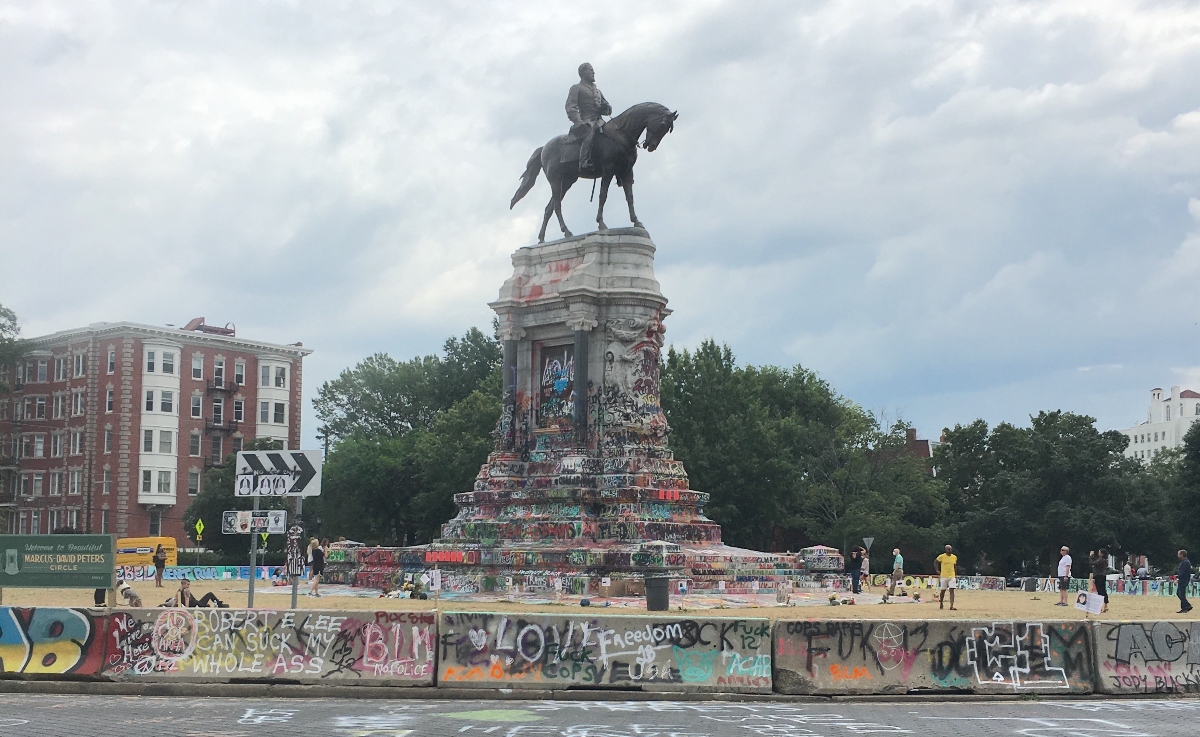How Protest Artists Transformed Whitewashed History

This poem and photo exhibit is the ninth piece in the 2020 Visions: Imagining (Post-) COVID Worlds series, which aims to reflect on the uneven impacts of the “pandemic year” and to consider new futures that might be made possible in its wake. Series editors: Weishun Lu, Juniper Lewis, Richelle Wilson, and Addie Hopes.
2020 was a year of twin pandemics. As the novel coronavirus spread across the globe, police violence in the United States drew renewed attention to the centuries-long disease of racial injustice. Black Americans were disproportionately affected by COVID. They were also the victims of ongoing state violence and racially motivated hate crimes.
The murders of Ahmaud Arbery, George Floyd, and Breonna Taylor drew crowds of protesters to the streets throughout the summer of 2020. All the while, a public debate about U.S. history resulted in the vandalization, transformation, and toppling of monuments across the country, especially in the South. Black Lives Matter uprisings took place alongside COVID lockdowns as protesters created new geographies, remade cityscapes, reignited arguments over public monuments, and imagined a more just world that might emerge from a time of deep mourning and crisis.
This poem and photo display are a reflection on Les James’s visit to the Robert E. Lee monument and protest art site in Marcus-David Peters Circle, Richmond, Virginia in the summer of 2020. – Editor’s Note
On purity and truth
“In this enlightened age, there are few I believe, but what will acknowledge, that slavery as an institution, is a moral & political evil in any Country. . . . I think it however a greater evil to the white man than to the black race, and while my feelings are strongly enlisted in behalf of the latter, my sympathies are more strong for the former. The blacks are immeasurably better off here than in Africa, morally, socially and physically. The painful discipline they are undergoing, is necessary for their instruction as a race, and I hope will prepare and lead them to better things.”
– Letter from Robert E. Lee to Mary Randolph Custis Lee (December 27, 1856)
“All that the South has ever desired was that the Union, as established by our forefathers, should be preserved; and that the government, as originally organized, should be administered in purity and truth.”
– Letter from Robert E. Lee to C. Chauncey Burr (January 5, 1866)

It is disquieting to stand in the shadows of a sixty-foot-tall monument,
looking up at someone who stood up to defend the political rights of those who elected to deny
the basic human rights of people who looked like you.
And it says a lot when the defacing of public property by people once treated as property
unmasks the true face of social propriety, and at last reveals properly
what has been concealed by expressions of public hypocrisy:
An old white man up on his high horse, forever at war with the people his elevation suppresses,
reigning over the graves of Black children, women, and men murdered at his feet,
even as he continues to lead the invisible ranks of all those
Who sanctioned the theft of black and brown lives,
whose livelihoods depended upon fields fertilized by black and brown blood,
whose freedoms were rooted in the oppression of black and brown people.
How does it make sense to expect people to show respect to those who have never respected them as people?
So this is how we expose the true colors of a monochromatic statue,
how we disrupt the monologue of its expertly crafted sentiment:
With colorful language—
With violent lashes of graffiti and bloody lines of spray paint
that leave blemishes like angry, festering wounds, and mar the cold unfeeling skin
of a monstrous monolith that refuses to acknowledge the foundations upon which it was built.
This right here is how we transform the silence
of a memorial dedicated to the perpetuation of violence,
into a loud celebration of our perpetual defiance:
By giving our own testimonies and bearing witness, faithfully,
against the white noise and white lies of a whitewashed legacy.
And this right now is the time for y’all to face the pure and simple truth—
that all this is our history, too.

Featured image: Les James, 2020
Les James is an emerging multimedia artist and writer. Her work has appeared or is forthcoming in Gumbo Magazine, Blueprint for Black Liberation Magazine (BlackRoots Alliance), Black Lives of Unitarian Universalist Meditation Manual, and the anthology The Future of Black: Afrofuturism, Black Comics, and Superhero Poetry. She currently resides on the occupied lands of the Powhatan Confederacy (Richmond, Virginia). Website. Contact.



You must be logged in to post a comment.